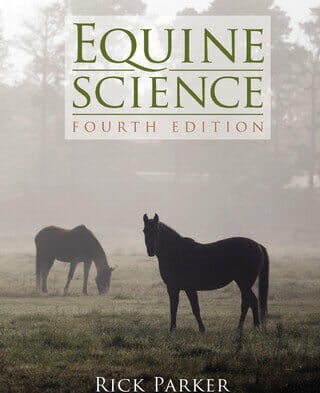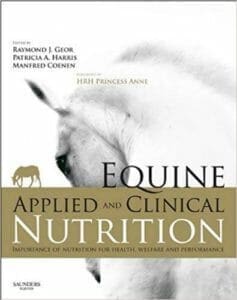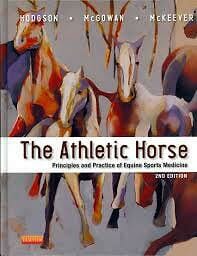Equine Science 4th Edition

By Rick Parker
Equine Science 4th Edition PDF uses a logical, easy-to-follow outline to make both learning and lesson planning simple, while addressing essential topics like care and feeding, training, development and reproduction, illness, inheritance, and the history of horses. Bursting with helpful features, this resource piques student interest with detailed graphics and photos, as well as informational sidebars, website references, and end-of chapter quiz activities. Future equine professionals will especially appreciate the glossary of terms at the end of the text, as well as the appendix, which includes useful conversion factors and worksheets and provides contact information for professional organizations.
- Boldly Illustrated in Full Color: More than sixty new color photographs and over one-hundred revised or new color illustrations bring the world of equine care and management to life.
- Newly Refined and Updated Topics: The 4th Edition of EQUINE SCIENCE includes the most current information on everything from breeds on the “Watch” list to green buildings to key website addresses and research data.
- Additional Content: All-new content with this edition includes a new section and photos related to mounted police, new information on current research, new information on zebra hybrids and a sidebar about Seabiscuit, expanded discussion related to the components of blood and immunity, horse reproduction, the digestive processes, FFA Career Development Events (CDE) on Horse Evaluation, Internet help for purchasing a horse, as well as sections on Genomics and Genetic Code Sequencing, Cloning and Genetic Engineering, Emerging Equine Diseases, and more.
- Powerful E-Resources: The 4th Edition’s fully revised version of the ClassMaster™ CD-ROM provides instructor tools like an Instructor’s Guide, PowerPoint® slides, an Image Library, and a test bank designed to take the hassle out of planning your course.
- Proactive Career Focus: Give students a lead in their job search with an FFA Career Development Event (CDE) on Job Interviews, as well as discussions on applying and interviewing for jobs, online applications, the importance of information literacy and soft skills, and the value of internships.
- Robust Resources: URL’s for Internet resources, references to the latest nutritional requirements, and detailed graphics all help students find the information they need to succeed in their studies and careers.
- Alignment to National Content Standards: Content was developed to align with the National Food, Agriculture and Natural Resources Career Cluster Content Standards from the National Council for Agricultural Education.
- Powerful E-Resources: The 4th Edition’s fully revised version of the ClassMaster™ CD-ROM provides instructor tools like an Instructor’s Guide, PowerPoint® slides, an Image Library, and a test bank designed to take the hassle out of planning your course.
- Specific Learning Objectives: Every chapter begins with learning objectives to pinpoint the most important material for students, and ends with student activities and critical thinking questions to reinforce the readings.
- Highlighted Key Terms: Making learning easier, the book highlights and explains must-know terms throughout the readings, and provides detailed definitions in a back-of-the-book glossary.
- Logical, Easy-to-Use Approach: Clearly written and thoughtfully organized, the 4th Edition of EQUINE SCIENCE uses an easy-to-follow outline that walks students through every aspect of equine care and management, providing them with the foundational knowledge employers want.
- Stimulating Visual Appeal: Color photos and illustrations, as well as tables, charts, and graphs give context to the concepts–particularly helpful with equine anatomy and physiology, and other complex scientific subjects.
Read more: Infectious Diseases of the Horse: Diagnosis, Pathology, Management, and Public Health, 2nd Edition
| File Size | 48.8 MB |
| File Format | |
| Download link | Free Download | Become a Premium, Lifetime Deal |
| There is a Newer Edition of This Book | |
| Support & Updates | Contact Us | Broken Link |
| Join Our Telegram Channel |  |
| More Books: | Browse All Categories |













![Ettinger’s Textbook of Veterinary Internal Medicine 9th Edition [PDF+Videos] Ettinger’s Textbook of Veterinary Internal Medicine 9th Edition [True PDF+Videos]](https://www.vet-ebooks.com/wp-content/uploads/2024/10/ettingers-textbook-of-veterinary-internal-medicine-9th-edition-100x70.jpg)

![Textbook of Veterinary Diagnostic Radiology 8th Edition [PDF+Videos+Quizzes] Thrall’s Textbook of Veterinary Diagnostic Radiology, 8th edition PDF](https://www.vet-ebooks.com/wp-content/uploads/2019/09/textbook-of-veterinary-diagnostic-radiology-8th-edition-100x70.jpg)






